Pamukkale hot springs is a spectacular sight in the Denizli Province in Turkey. When you look at Pamukkale hot springs from afar, you will rub your eyes to ensure you’re not seeing a fluffy cotton cloud. In Turkish, Pamukkale stands for “Cotton Castle.”
Now, you’re probably wondering why they nicknamed Pamukkale “Cotton Castle.” Just one glance at the place and all the puzzles on why the site is known by that name will fall into place.

Pamukkale Hot Springs — The Optical Illusion
The terraces of Pamukkale hot springs are made up of travertine. Travertine is formed when calcium carbonate minerals encounter the surface, hardening into a gel and later, into peculiar white stones.
The travertines of Pamukkale hot springs shimmer from a distance, hang down from the cliffs, and hang like long pieces of cotton between pools.

The white-coloured limestone terraces look like an enormous castle made of fluff and cotton or a series of cotton clouds.
The breathtakingly beautiful sight stands 160 m tall, 2,700 m long, and 600 m wide. For centuries, the Cotton Castle in Turkey has exceeded the expectations of visitors with its beauty.
These travertine hot springs in Pamukkale feature several flowing white pools with vivid turquoise-coloured surfaces.
The warm, mineral-rich water fills the limestone pools, making it the perfect relaxation spot in Pamukkale, Turkey.
Cotton Castle in Pamukkale, Turkey doesn’t just warm your soul but also acts as a natural healer.
The Healing Powers of Pamukkale Hot Springs
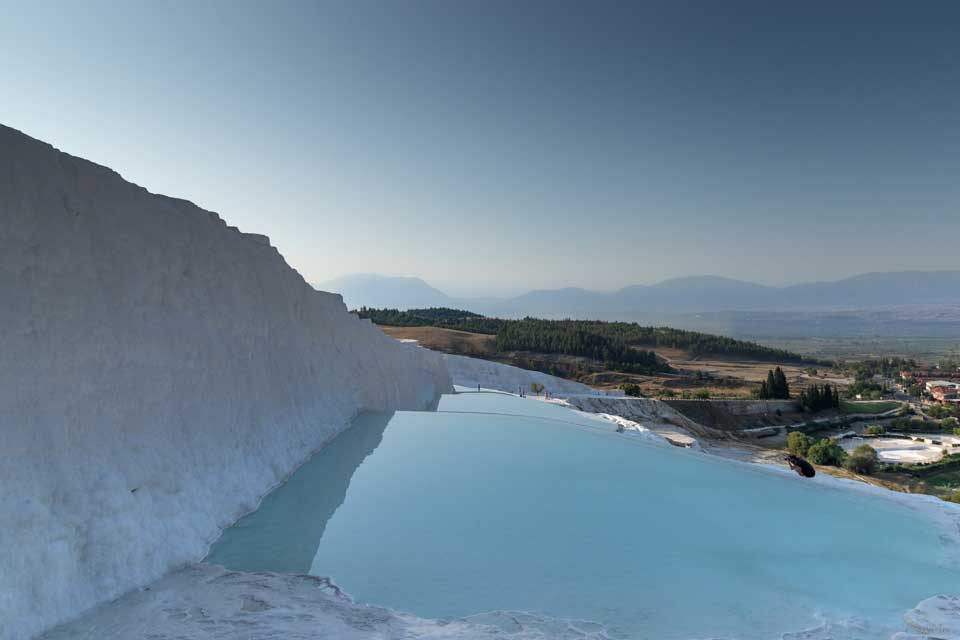
What powers the waters of Pamukkale hot springs? While you soak in the thermal pools, 300 m under the Anatolian Plateau’s surface, water bubbles loaded with minerals stream continuously into the pool.
What’s making the water so hot? — Volcanic activity and a fault line. This is where we get scientific. The toxic carbon dioxide gas, found in the subterranean caves, pushes the water bubbles to the surface. The hot bubbles then travel through the cliffs and into the 17 Turkey Travertine Pools.

Don’t worry! The water is not too hot to get in. The temperature in the pools stays between 19C and 57C.
The instant you dip into the pool, you’ll feel immediate comfort. The liberation from stress and worries comes from stepping into a mixture of beneficial minerals.
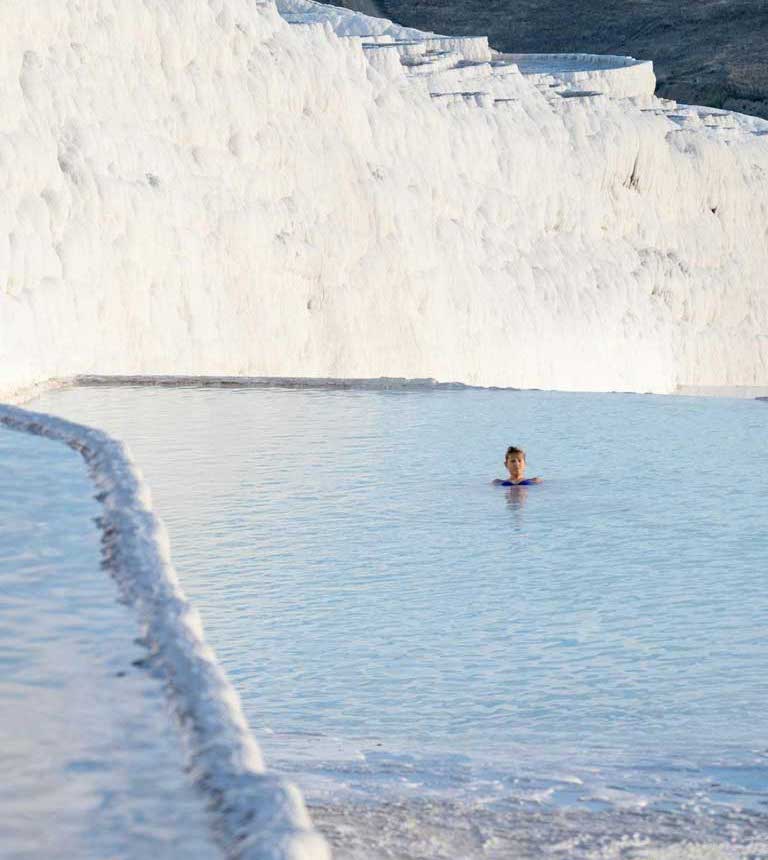
They include colloidal iron, bicarbonates, and also calcium carbonate. Combined, these minerals are said to offer people numerous benefits and relief from certain ailments.
People have been aware of Turkey Calcium Pools’ healing powers since the 2nd century BC.
The exotic-looking pools, infused with calcium, are believed to help people with asthma, high blood pressure, skin diseases, asthma, and more. Whether you believe it or not, it doesn’t matter because it’s the warmth of the water and the gorgeous white backdrop that pulls people in.
Formation of the Hot Springs in Pamukkale

A volcanic event occurred over two million years ago, which produced the terraces, causing them to develop on the slope. Consequently, several mountains sprung up and the earth’s crust started to erupt. Thereafter, earthquakes followed, leaving cracks in the surface.
Rainwater ran past the cracks and blanketed a layer of thick limestone. This kept happening for several thousand years. The heat then pushed calcium carbonate out onto the surface to form the white terraces. Here’s how it works:
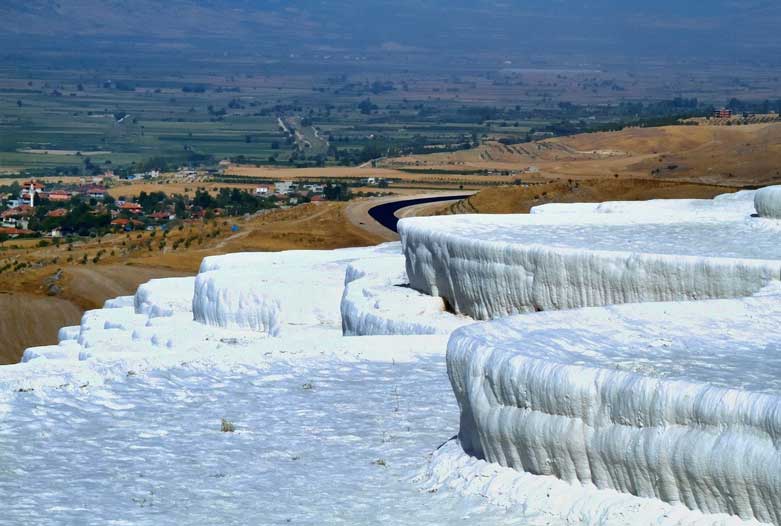
The mineral-rich water resurfaces when the temperature is more than 35 C but disappears when the temperature is below 35 C. The cool weather leaves white sediment onto the surface, which then transforms into a wondrous white limestone terrace. Hence, some people call it Cotton Castle in Turkey.
Let’s take a deep dive into the myths and history of Pamukkale next.
The Untold Legend and History of Pamukkale Hot Springs
Pamukkale hot springs have a historic beginning intertwined with legends heightening the destination’s allure. Pamukkale stands in the same location where the ancient city of Hierapolis once stood.
Now, more than 2,000-year-old Greek ruins surround the impressive Travertine Pools in Turkey.

Look beyond the ruins of Hierapolis Turkey and the beauty of the pools to uncover dark sinister tales
The Giants
One quirky and imaginative tale on how the hot salt baths in Turkey got their white snow will make you chuckle. It’s said that giants used to wash their laundry in the thermal pools, and then one day, they disappeared but left their cotton in the sun to dry.
The Extreme Makeover
In Turkey, there once lived a poor and plain-looking girl. She was conscious about the way she looked until one day she could no longer take it. She jumped into a hot spring in Pamukkale. But before you get sad, know she emerged from the heated waters looking ravishing. A lord seeing her in the water rescued her and married her. She’s Turkey’s very own Cinderella. Her story also reinforced people’s belief of Pamukkale’s hot springs healing properties.
The Mysterious Cave
An extraordinary discovery made 2,000 years ago revealed the portal to the underworld, hidden beneath the Cotton Castle in Pamukkale, Turkey. Hierapolis’ eunuch priests called Galli ventured into the unknown to find an abandoned and unexplored cave.
Fog cloaked the dim cave, making it harder for the priests to see the floor. They had brought animals with them, which before their eyes, became weak and died instantly. The priests, unharmed from the strange mist, declared the cave as a portal to the underworld.
They explained their unharmed state by saying that the Gods had protected them due to their undying devotion to them.

Soon, the priests decided to share the cave with the public, calling it the Ploutonion in honour of the Greek God of the underworld, Hades. They would host elaborate displays for people by walking into the cave with a bull and coming out alone to face the cheering crowd.
Although modern science has solved the mystery by recognising the substance in the cave as carbon dioxide, it still makes for an enjoyable tale. If you’re wondering how the priests stayed alive, it’s because the gas pooled on the floor, so animals with noses to the ground inhaled it, unlike humans who walk upright.
Doctor’s Salt Pools Prescription
The nomad Phrygians, according to some historians, were ancient people who migrated from Southeastern Europe to Anatolia, Turkey. The Phrygians seized and built structures on Pamukkale in early 600 BCE. At that time though, they didn’t realise the value of the thermal pools. Turkey Travertine Pools gained momentum with the masses in the 2nd century when the holy city of Hierapolis became synonymous with “healing.”
Once the doctors believed in the pools’ curative properties, they started prescribing patients to take daily baths in the salt pools in Turkey. It didn’t take long for the word to spread with thousands of people travelling to Pamukkale to benefit from the hot springs’ healing powers.
The Graveyard
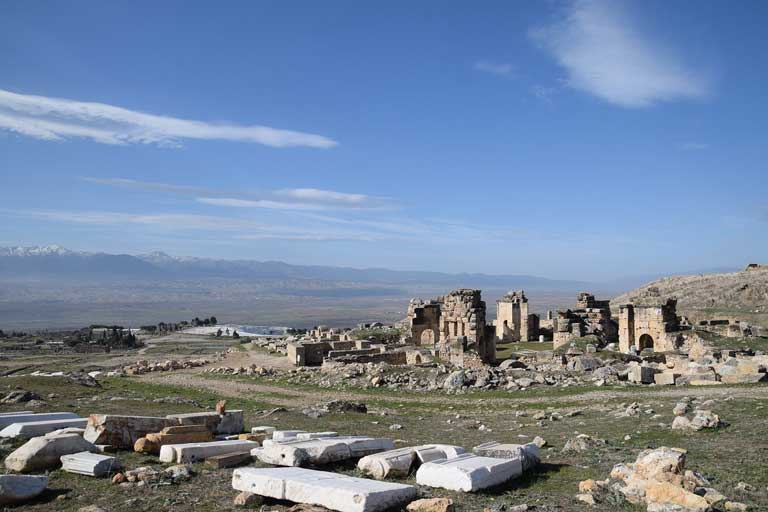
Although people travelled to Pamukkale in numbers, not everyone was fortunate enough to return home with several passing away. Their unmarked graves can be found in a necropolis in ancient Hierapolis.
A necropolis is a huge graveyard located outside of the city’s walls. Archaeologists have uncovered over 1,200 graves.
Earthquakes and Early Christian Crusades Changed the Landscape of the Historic Hierapolis
The arrival of Christianity in Hierapolis in the 3rd and the 4th century saw temples shutting down or being converted to other buildings. Army invasions and earthquakes further damaged the great city. However, in that devastation, there was a silver lining. The natural disaster led to the creation of the Cotton Castle in Turkey.
The cracks in the surface created the exotic and one-of-a-kind travertine with its white cotton and fluffy cloud-like appearance. It covered every inch of Hierapolis, only leaving a few reminders of the ancient city behind, including Cleopatra’s Pool.
Visiting Pamukkale Hot Springs
The Manmade Wonder of Cleopatra’s Pool
Cleopatra’s Pool in Pamukkale is one of the main tourist attractions in Turkey. Cleopatra’s Pool is a creative show of love and devotion. Roman general and politician Mark Antony built the structure as a gift to his wife Cleopatra, the Egyptian Queen.
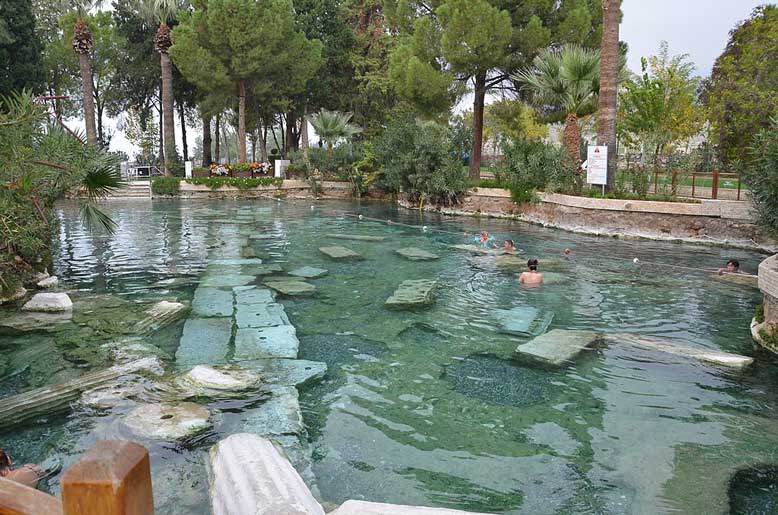
The 7th century brought devastation and destruction to Pamukkale, including the pool. The Roman Temple to Apollo was destroyed in the wake of the earthquake with its ruins plummeting down into the pool.
The ancient structure’s columns remain a central attraction for tourists who visit Cleopatra’s Pool. You can swim around the columns and the ancient statues underwater. You can also just soak in the pool and reap the benefits of the water’s healing properties believed to alleviate a large variety of illnesses such as digestive issues, skin problems, arthritis, and asthma.
The temperature stays between 36C and 57C. There’s an entrance fee to go into the pool but sitting outside the pool is free. There’s also a wonderful café you can grab snacks from. If you want to visit Cleopatra’s antique pool, it opens every day from 9 am to 7 pm.

Pamukkale Hot Springs Entrance Fee (Updated April 2024)
The entrance fee to visit Pamukkale hot springs is 30€ for each person. For children under 8 it’s free. The entrance fee includes the visit to the sacred city of Hierapolis as well as the Archeological museum. You need to buy a separate ticket for Cleopatra’s Pool.

Cleopatra’s antique pool entrance fee is 9€ for each person and you will also have to pay an additional fee of less than 1€ for a locker. You will need to bring your own towel.
Note: As the Turkish Lira has been unstable for some time now, the fees may be slightly different.
Pamukkale Hot Springs Opening Hours
The opening hours for Pamukkale thermal pools are from 6:30 am to 11 pm each day of the week from Apr 1st to Oct 1st in summer, and in the winter from 10 am to 4 pm.
Can You Wear Shoes in the Travertine Terraces of Pamukkale?

Not really, you can’t wear shoes in the Turkey Travertine Pools. The thermal spring terraces contain several gallons of turquoise-coloured water with an abundance of minerals. Walking without shoes ensures the calcium deposits that naturally develop on the terraces don’t succumb to corrosion.
What are the Salt Pools in Turkey Made Of?
Turkey’s salt pools are made from white-coloured limestone walls. The limestone terraces look like a castle made from fluffy cotton. Calcium-rich hot water streaming in from the thermal springs is responsible for creating the limestone pools. The calcium carbonate softens and then hardens to form limestone.
What’s the Pamukkale hot springs location? The location of Pamukkale thermal pools is in the Denizli province in Turkey, near the ancient ruins of the city Hierapolis.
How to get to Pamukkale from Istanbul? To get to Pamukkale from Istanbul, you can get a 10-hour bus trip to Denizli, and then another trip from Denizli to Pamukkale, which will take approx 20min. The quickest way from Istanbul to Pamukkale is by plane – the flight should be no longer than 1h 20min.
Can you swim in Pamukkale? Yes, you can swim in the limestone thermal pools in Pamukkale. Swimming in Cleopatra’s pools is also allowed.
Submerge Yourself in Pamukkale
Once in Pamukkale, besides the healing properties of the limestone pools, and bathing in Cleopatra’s pool, you will be exposed to numerous other pleasures.
In case you are interested in ancient history, you can visit the ancient city of Hierapolis. If that was not enough, you can then book a Pamukkale balloon flight and see the Cotton Castle from a different perspective.
Additionally, you can take amazing sunset photos of the Pamukkale limestone terraces.
Spectacular Sunset at Pamukkale Turkey
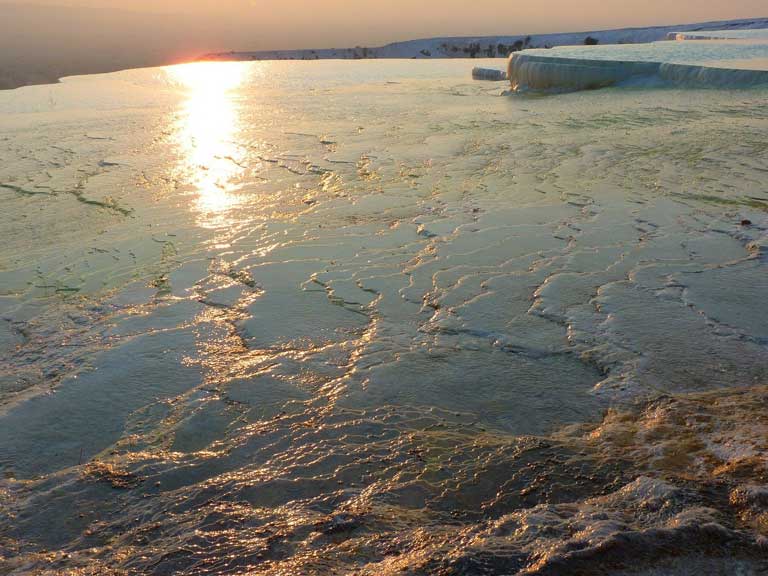
The sunset at Pamukkale in Turkey evokes feelings of serenity and calmness. The jaw-dropping and eye-opening wonder happening in the sky will amaze you! You’ll find yourself lost in the amazing colours dazzling in the sky and reflecting in the water.
The small cloud-like limestone terraces will shine differently under the yellowish-orange light. If you want to see the colours put on a show, reach the Travertine Pools in Turkey sooner.
You can see the staff at work and note the pools they are redirecting water to from other pools.
They should be finished before sunset. The next step is to find a pool, stand by it, and wait for the sunset to paint the sky.
Pamukkale Hot Air Balloon

What other things to do in Pamukkale? Give your feet a break and explore Pamukkale from the sky! Take a hot air balloon ride to rediscover Pamukkale hot springs and its surroundings.
When you are in a hot air balloon, slowly drifting in the sky, you’ll discover that there’s a sense of serenity and peace in the open air.
Professional pilots take you on an incredible and unforgettable hot air balloon experience in Turkey. Most tours start in the peak hours of the morning. Once onboard, you will rise to an altitude of 1000 m and then look out to see the panoramic 360-degree sights before you. Choose a flight from 5 top Pamukkale hot air balloon tours and have a memorable experience.
Ancient City of Hierapolis in Turkey
In Pamukkale, you can visit the ancient city of Hierapolis. Now, only ruins of the city remain but it still manages to draw curious onlookers. The Byzantine and Greco-Roman city was built on limestone deposits on top of the thermal springs.

The city became popular when the Romans discovered that the Hierapolis calcium hot springs have healing properties. Eumenes II, the King of Pergamon, received the city as a gift from the Romans. The King named the city Hierapolis after the Pergamene Dynasty founder Telesphorus’ wife Hiera.
As the 20th century neared, hotels appeared on the site, thus causing further damage to the city. Fortunately, in 1988, UNESCO World Heritage declared it as a protected site. Travellers on a holiday can visit the ruins, including the necropolis that holds the tombs of prominent people such as the Roman ruler and Stoic philosopher Marcus Aurelius.
Pamukkale Hot Springs Gives New Meaning to the Word “Relaxation”

Submerge yourself in the warm, mineral-rich salt pools in Turkey. When you visit Pamukkale hot springs in Turkey’s Denizli province, you’ll emerge as a new you — revitalised, fresh, and relaxed.
Travel to the Cotton Castle in Turkey to witness stunning scenery and feel the weight of the world lifting off your shoulders as you soak in a salt bath.





